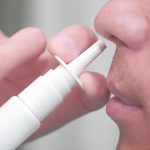
A nasal spray containing a ketamine derivative appears to beat one of the standard drugs used for people with difficult-to-treat depression, a new clinical trial has found. The trial, of nearly 700 people with treatment-resistant depression, found that esketamine nasal spray was more effective at sending patients into remission than a standard oral drug called quetiapine (Seroquel). After eight weeks, 27% of esketamine patients were in remission, versus 18% of those given quetiapine. By week 32, half of esketamine patients were faring that well, compared with one-third of those on quetiapine. Experts said the findings, published in the Oct. 5 issue of the New England Journal of Medicine, strengthen the case that esketamine is a good option for people with treatment-resistant depression. The condition, which plagues up to 30% of people with depression, is generally diagnosed when a person’s symptoms have failed to yield to at least two standard antidepressants. It’s a situation that places people at increased risk of hospitalization and suicide. There are a few medications approved in the United States as an “augmentation” therapy for treatment-resistant depression — meaning they are used along with a standard antidepressant. Quetiapine is one of them, and so is esketamine nasal spray, which has been available since 2019 under the brand-name Spravato. That approval was based on research testing esketamine against a placebo nasal spray. The… read on > read on >


























-300x200.jpg)










